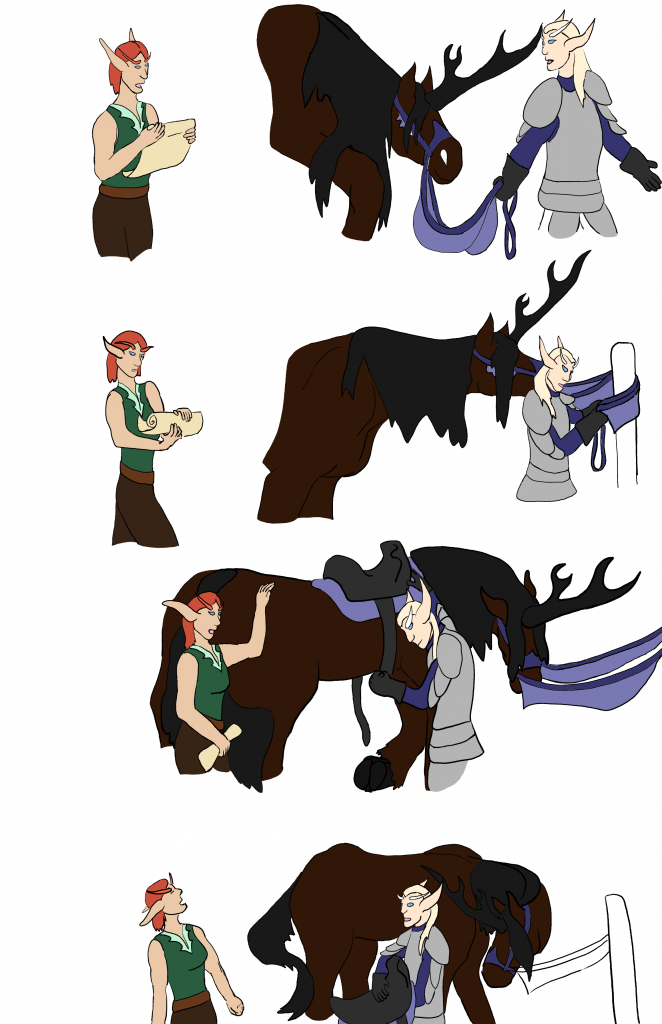I’m working on finishing up Page 4 of the Trials Web Comic series. Here’s that sneak preview I was promising:

While we’re speaking of drawing things: tying non-split reins to fence posts–how does it work?
Well, actually, it doesn’t, because you’re never supposed to tie a horse up by their reins–they can rip their lips out if they decide to be bright little horse-monsters and set back at the rail. When I worked at a trail-riding facility at a summer camp, we had a horse this very thing had happened to. His lips were partly missing and so forever curved upward at the back, giving him his camp name, “Smiley”.
The bridle shown here isn’t a bit-type bridle (it’s instead what they call a hackamore), and the reins also have those fancy dangling things to get in the way. So again, tying reins to fenceposts, how does it work? Heck if I know…it’s just a WIP comic page!
But may I also use the opportunity to rant on an old fantasy cliche that bothers me? That cliche is: elves (and other “nice” nature-y races) riding horses without saddles. THIS IS BAD, MMKAY? Riding a horse bareback is not kinder to the horse, it’s actually more painful for long rides. It’s like wearing shoes without socks, or walking on rocks all day long without shoes. Sure, it’s fine once in a while, but not as a routine thing. Your little bony butt is not comfortable pressed against their rib cage (and to make this not all about the horse, their spine against your privates isn’t terribly comfortable either, unless you have an amazing seat.) Fossil records show evidence of injury to the ribs and spine of horses before saddles were invented. That’s right, in their very bones! That’s some heavy duty damage!
Instead, picture it this way: a human is about as heavy to a horse as a hiking backpack is to you, and the saddle itself is like the extra padded shoulder straps and waist straps of said backpack. It helps spread your weight over a wider area, meaning more comfort and a more enjoyable experience for everyone. (If you ride Western, it also gives you a convenient little handle should things go wrong!)
For the record, the stirrups of saddles are also pretty important if you’re going to do anything requiring stability off of a horse’s back, like shoot a bow or go jousting.
So why has this cliche made it into our common narratives? I feel it may have to do with our modern (well, less modern these days) portrayal of Native Americans. In many pictures, they are shown riding their horses bareback, and we often perceive Native Americans as treating the land and their horses well. Therefore, horses without saddles is a good thing, right?
Well, no, as explained above. I believe this image is a bit misleading in several ways. The thing is, crafting a good saddle is a skill. It takes knowledge of horse anatomy to do it well, skill in the actual crafting of the thing (leatherworking, possibly some carpentry with saddles that have wood inside as support), and having the right materials and tools for all this on hand. By the time the Native Americans were using horses, they had become something of a refugee society. Disease and encroachment by settlers kept them on the move constantly and disrupted any long-standing societal staples, like the tradeskills going into saddle-making might fall under.
That’s my theory, at any rate! Either way, in my opinion, if you want to show a fantasy society that is kind to their horses, remove the bit instead. Though some horses are carrot-brains and need the extra reminder that a hard bit provides, this is the most uncomfortable part of traditional riding tack to a horse.
